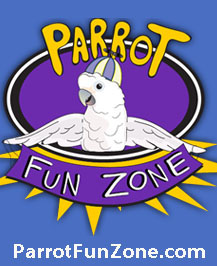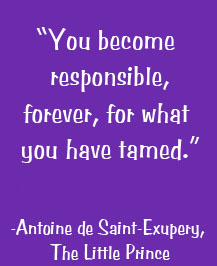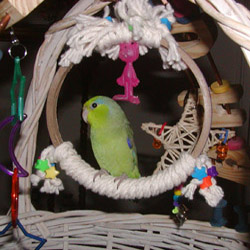 As with kids, no toy is 100% safe for all birds. A parrot relies on its owner to make sure its playtime activities are safe. Selecting the right toy is one way you can keep your bird healthy and injury free. There are several factors that must be considered in making a safe toy selection for your bird:
As with kids, no toy is 100% safe for all birds. A parrot relies on its owner to make sure its playtime activities are safe. Selecting the right toy is one way you can keep your bird healthy and injury free. There are several factors that must be considered in making a safe toy selection for your bird:
- Size appropriateness
- Construction of the toy (materials, design)
- Knowledge of your bird's individual toy personality and play style.
Size Considerations
Any toy has the potential to be unsafe if improperly sized to the bird. For example, a toy meant for a small bird is often constructed with components that could pose choking hazards to large birds and, conversely, toys meant for larger birds could pose a risk of entrapment. Small brittle plastic parts may be perfect for a little bird but could easily shatter into sharp splinters when subjected to the power of a large bird's beak.
Construction Aspects
A toy that is 100% safe for one bird may pose a risk to another bird. Both design and material suitability must be assessed by a bird owner.
Design
Poorly designed toys can present a risk of injury to your bird. Some questions to keep in mind are:
- Are there loops of a size that your bird is at risk for getting his head stuck in?
- Are there small openings that could pose a risk of toe or nail entrapment?
- Is there a long length of exposed rope, leather or chain that could pose a risk of strangulation if the bird tosses the toy and it wraps around its neck?
- Is the type of hardware used appropriate to the size of the bird the toy is designated?
- Are there any small parts, if removed, that could cause soft tissue injury to your bird's mouth? (i.e., screws, eyes, small wires)
Materials
Reputable manufacturers choose to use only the safest components in the construction of their toys. However, materials that are completely safe for a budgie may be extremely hazardous to a large bird. It is important to know what safety issues must be considered relative to the materials commonly used in toys
Wood
- Make sure the wood used in your toy is from a "safe" tree.
- Safe woods (partial list) include: Pine, Balsa, Bamboo, Beech, Birch, Basswood, Cajeput, Dogwood, Douglas Fir, Hickory, Poplar, Maple, Walnut, Ash, Apple, Elm, Cactus (Cholla) and Manzanita.
- Unsafe woods (partial list) include: Cedar, Cherry, Plywood and Oak.
- Make sure the wood is colored only with non-toxic food coloring or vegetable dyes.
- If you are interested in a toy with painted parts (i.e., ABC blocks) make sure that only non-toxic, child safe paints were used.
Rope
- Only 100% natural fiber ropes such as cotton, hemp, jute or sisal should be used in bird toys.
- Rope toys can be safe as long as they are maintained properly and the bird’s beak and nails are kept trim.
- Bird owners have a responsibility to check their bird's rope toys daily and to cut back or discard rope toys when they become frayed or present a hazard to their bird.
Chain
- Chain should have welded not open links. Un-welded chain provides sharp surfaces and narrow openings which have been known to cut toes.
- Make sure the links are a safe size for your bird. If a bird's toes get caught in the links the result can be a broken nail, toe or leg.
- Chain length is also a consideration. A long length of chain could conceivably end up wrapped around a bird’s neck during a vigorous play session. As the wood components are chewed off, a chain hazard could develop.
Fasteners
- Never purchase toys that use split key rings, spring loaded clips or metal shower rings as fasteners.
- Small hardware pieces can be ingested accidentally or cause mouth injuries.
- Quick-link or Pear link type connectors are recommended to attach toys to the bird's play area. This type of fastener provides the least potential for injury.
Plastics
- When considering toys with plastic components a bird owner must consider the nature of the plastic component (i.e., soft vs. brittle) relative to the size of the bird.
- Brittle plastics should not be given to larger birds because when they break very sharp, cutting edges are formed and if swallowed accidentally could result in ruptured organs.
- Hard plastic toys specifically designed for parakeets and cockatiels should not be given to larger birds.
Leather
- Only vegetable tanned leather should be used on bird toys.
- Do not buy toys with dyed leather or leather tanned with chemicals as most are toxic to birds (i.e., chromium, formaldehyde). For this reason you should not retire old shoes, belts and pocketbooks to your birds toy chest.
- Replace leather if soiled or wet. Bacteria will flourish under these conditions.
- When hanging toys strung on leather (or rope or chain), avoid leaving a long strand between the toy and the cage. Some birds, when rambunctious with their toys, can get the leather wrapped around their necks and strangle. It is best to tie the toy close to the bars of the cage.
Rings
- When choosing toys with rings or large plastic chain links, make sure that the rings are of a size that the bird can’t get his head stuck in the rings and choke.
- Also, beware of toys with multiple rings looped directly together, as birds have met similar fates when they have been trapped between the rings.
Bells
- If a bird is mechanically inclined and can remove the bell clapper, the potential exists for swallowing/choking.
- Make sure the bell clapper can not be removed by the bird. If it is not securely fastened remove it.
- Make sure the clapper is not lead (toxic). If it is lead, you will be able to dent the clapper with your fingernail.
- Do not buy toys that use jingle type bells, toes can become caught and cut in the wide to narrow openings. We recommend the cow or liberty bell designs.
- Appropriately size the bell to the bird so it will be able to withstand the power of the beak.
Observation & Knowledge of Your Bird
Ultimately, only a bird owner can determine whether a toy is suitable for their bird based on the close observation and knowledge of their bird's interaction with toys. Studying your bird while they are playing will help you to choose toys well suited to your bird's individual personality and play style.
Supervision is the absolutely best defense against a toy related injury.
Use common sense and supervise your bird when you first give him a new toy. Observe how he interacts with the toy to determine how best to hang it and where and when to allow him to play with it (some toys are safer outside the cage).
If in doubt, take it out!
If your bird is extremely aggressive with his toys and puts himself at risk of getting bopped in the head or wrapping it around his neck then maybe hanging toys are not the best for use within his cage when no one else is there to supervise. Bolt-on toys are a good alternative in this instance.
Summary
Toys are critical to your parrot's well-being and serve as a substitute outlet for the many activities they would engage in daily, in the wild. Although no toy is 100% safe, don't let your concerns over safety overwhelm your thinking. You can ensure your bird's safety by taking a reasoned approach. The critical steps towards ensuring success are to:
- Evaluate a toy's suitability before purchase based on the criteria presented above.
- Examine the toy upon receipt to ensure that there are no dangerous defects (i.e., sharp edges, broken welds)
- Observe your bird's interactions with his new toy and determine whether he can continue to play with the toy unsupervised.
- Inspect your bird's toys daily to ensure that their condition remains safe and make repairs as necessary. Owners must monitor the status of toys and ensure that as they physically change, safety hazards do not develop (i.e., through fraying, exposure of rope due to chewed off parts, etc.) For advice on how to clean your bird's toys check out Cleaning Your Bird's Toys and Accessories.
- Maintain your bird's nails and beak to minimize the potential for entrapment. For further guidance regarding grooming check out our articles Beak Bytes and Nail Nibbles.
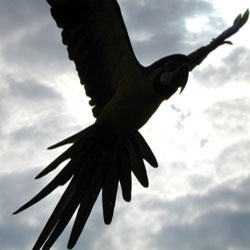 There may come an unfortunate time when your parrot companion is lost or stolen. There are several steps you can take to prevent theft or loss.
There may come an unfortunate time when your parrot companion is lost or stolen. There are several steps you can take to prevent theft or loss.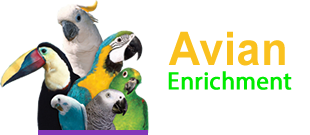

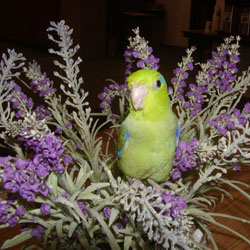
 As with kids, no toy is 100% safe for all birds. A parrot relies on its owner to make sure its playtime activities are safe. Selecting the right toy is one way you can keep your bird healthy and injury free. There are several factors that must be considered in making a safe toy selection for your bird:
As with kids, no toy is 100% safe for all birds. A parrot relies on its owner to make sure its playtime activities are safe. Selecting the right toy is one way you can keep your bird healthy and injury free. There are several factors that must be considered in making a safe toy selection for your bird:

